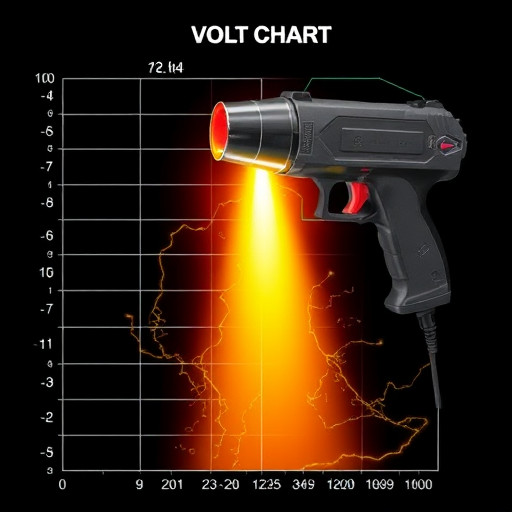Stun guns, or electronic control devices (ECDs), use electric shocks to temporarily disable targets. Their effectiveness is measured by voltage output, with higher voltages delivering more powerful jolts. A stun gun voltage chart offers crucial insights into electrical performance, considering factors like current, pulse width, and energy output alongside voltage. This chart helps users select the optimal device based on their needs and the situation, balancing protection and safety. While higher voltages generally increase power, other considerations such as electrode design, device size, weight, and environmental conditions also impact effectiveness.
“Uncover the power behind stun guns and their effectiveness as a personal safety tool. This comprehensive guide explores the science behind stun gun functionality, delving into key aspects like voltage and its impact on immobilization.
We present a detailed Stun Gun Voltage Chart, your go-to reference for understanding different voltage levels and their effects. Learn how various factors influence the overall effectiveness of stun guns, empowering you with knowledge to make informed decisions regarding self-defense.”
Understanding Stun Gun Functionality and Safety
Stun guns, also known as electronic control devices (ECDs), operate by delivering a powerful electric shock to temporarily incapacitate a target. Unlike traditional firearms, stun guns do not use projectiles but rather rely on high voltage and low current electrical pulses to disrupt muscle control in the body. The effectiveness of a stun gun depends heavily on its voltage output. A stun gun voltage chart can provide valuable insights into different models’ capabilities, with higher voltage typically translating to more powerful shocks.
Safety is a paramount concern when discussing stun guns. Proper training and understanding of their functionality are essential. Users must be aware of the weapon’s range, activation mechanisms, and de-activation processes. Additionally, knowing the legal implications and ensuring compliance with local regulations is crucial. Despite their non-lethal nature, stun guns can cause significant pain, disorientation, and temporary paralysis, making them powerful tools for self-defense when used responsibly.
Deciphering Voltage: What Does It Mean?
Deciphering Voltage: What Does It Mean?
When discussing stun guns, understanding voltage is key to comprehending their effectiveness. Stun gun voltage chart serves as a useful tool for comparing different models and gauging their impact on an assailant. The voltage represents the electric charge delivered by the device, measured in volts (V). Higher voltage generally translates to more powerful jolts, aiming to incapacitate individuals quickly. However, it’s crucial to note that voltage alone doesn’t determine stun gun effectiveness; factors like current, pulse width, and energy output also play significant roles.
A stun gun’s voltage chart offers insights into its electrical performance, detailing the amount of voltage delivered under various conditions. This data helps users make informed decisions when choosing a stun gun suitable for their needs. By comparing these charts, individuals can assess the intensity of the shock, ensuring they have a device that provides the desired level of protection without causing unnecessary harm.
Stun Gun Voltage Chart: A Comprehensive Guide
When considering a stun gun for self-defense, understanding its electrical output is crucial. A stun gun’s effectiveness largely depends on its voltage. Stun guns deliver an electric shock through two prongs, with the current designed to disrupt muscle control and cause temporary incapacitation. The voltage chart acts as a comprehensive guide, offering insights into different stun gun models and their power levels.
This chart typically ranges from lower voltages suitable for personal defense scenarios to higher ones meant for more aggressive applications. While 10,000 volts may be sufficient to stop an assailant with a single well-placed shot, 50,000 or more is often required for larger individuals or resistance-based situations. A detailed stun gun voltage chart breaks down these differences, empowering users to choose the device that best aligns with their needs and ensuring optimal effectiveness in various situations.
Factors Influencing Stun Gun Effectiveness
The effectiveness of a stun gun largely depends on its voltage, which is measured in millions of volts (MV). A stun gun voltage chart can provide valuable insights into this aspect. Generally, higher voltage means more powerful shocks and greater immobilization potential. However, it’s not just about the number of volts; other factors also play a significant role.
Among these factors, electrode design and placement are crucial. Properly positioned electrodes allow for optimal current flow through the target, enhancing the stun gun’s effectiveness. Additionally, the size and weight of the device can impact user comfort and control, indirectly affecting its performance. Weather conditions can also be a variable; wet or slippery environments may reduce the stun gun’s efficiency due to altered electrical conductivity.
